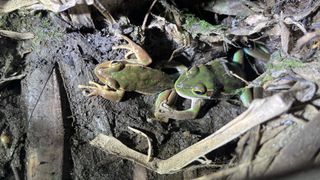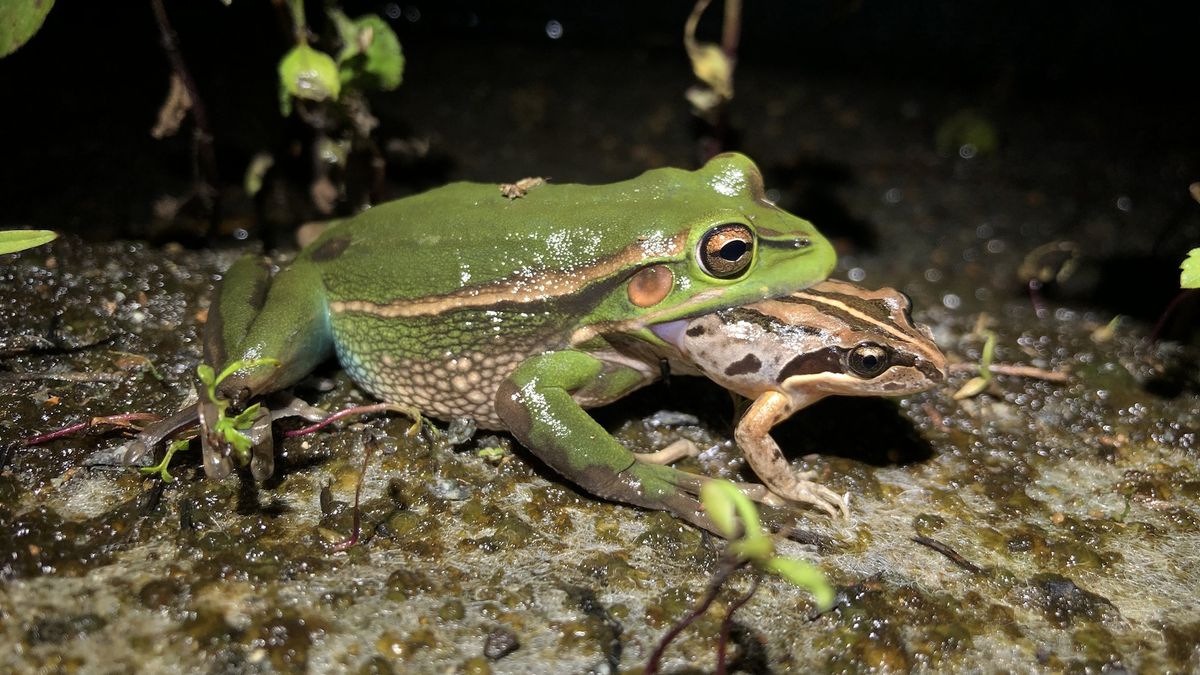Breeding seasons can be dangerous for males frogs that attempt to impress a potential mate: They can quickly find themselves being dragged and eaten by an unimpressed female, researchers have discovered.
For the first time, researchers on Kooragang Island in New South Wales, Australia have observed adult female green and golden bell frogs (Litoria aurea) hunt their male counterparts during the breeding season. They detailed their findings in a study published June 12 in the journal Ecology and evolution.
The researchers first observed this behavior during a survey when they heard a loud scream.
“You sometimes hear it in the field, and it’s often a frog that has survived,” the study’s lead author John Goulda postdoctoral fellow in population ecology at the University of Newcastle, Australia, told LiveScience.
After following the screams, Gould discovered that the distress sounds were coming from a male with his thigh almost completely consumed by a larger female. She dragged him into a hole on the bank of a pond.
“The male frog was really trying to stop this from happening, so it grabbed everything around it, like sticks in the ground, to keep itself from being pulled in,” Gould said.
The male finally managed to escape. The observation prompted Gould and his team to compare their nocturnal field observations of three consecutive breeding seasons with other studies reporting cases of sexual cannibalism.

Cannibalism is well documented in amphibiansbut most reported cases involve either adults cannibalizing juveniles emerging from the water or tadpoles cannibalizing each other, Gould said.
Amphibian Cannibalism usually occurs when large numbers of the animals congregate in the same area, such as when tadpoles emerge from eggs and when there are significant size differences between predators and prey.
Many species of frogs are sexually dimorphic – adult females are often significantly larger than males.
“There is a very good possibility that females can exploit their male counterparts, not only as breeding partners, but potentially as prey,” Gould said.
The researchers speculated that this cannibalism may act as a natural selection process.
Females can distinguish between potential mates or prey based on the quality of their calls during the breeding season. Larger males with deeper calluses may be seen as better breeding partners, leaving smaller, inferior males as potential meals.
But Gould suggested that the superior mates might not escape predation either. Instead, when females have dumped all their eggs after breeding, they may choose to eat their mate – similar to female praying mantises, which decapitate and eat their mates during or after mating.
“It’s risky for male frogs out there. They cry their little hearts out to find a mate, but they just have to take on this extra risk of maybe being used as prey,” Gould said.
Scientists still don’t know for sure what influences these cannibalistic behaviors. Observations of sexual cannibalism are rare because they occur quickly. But this may not mean they are rare, Gould said.
Gould points out that field observations of amplexus — when a male frog mounts a female to fertilize her eggs — are also relatively rare, even though scientists know it’s necessary for breeding.
Further research is needed to determine how frequent these cannibalistic events are and how they affect local populations of green and golden bell frogs, the team said.
#risky #male #frogs #female #frog #pulls #eat #screaming #male
